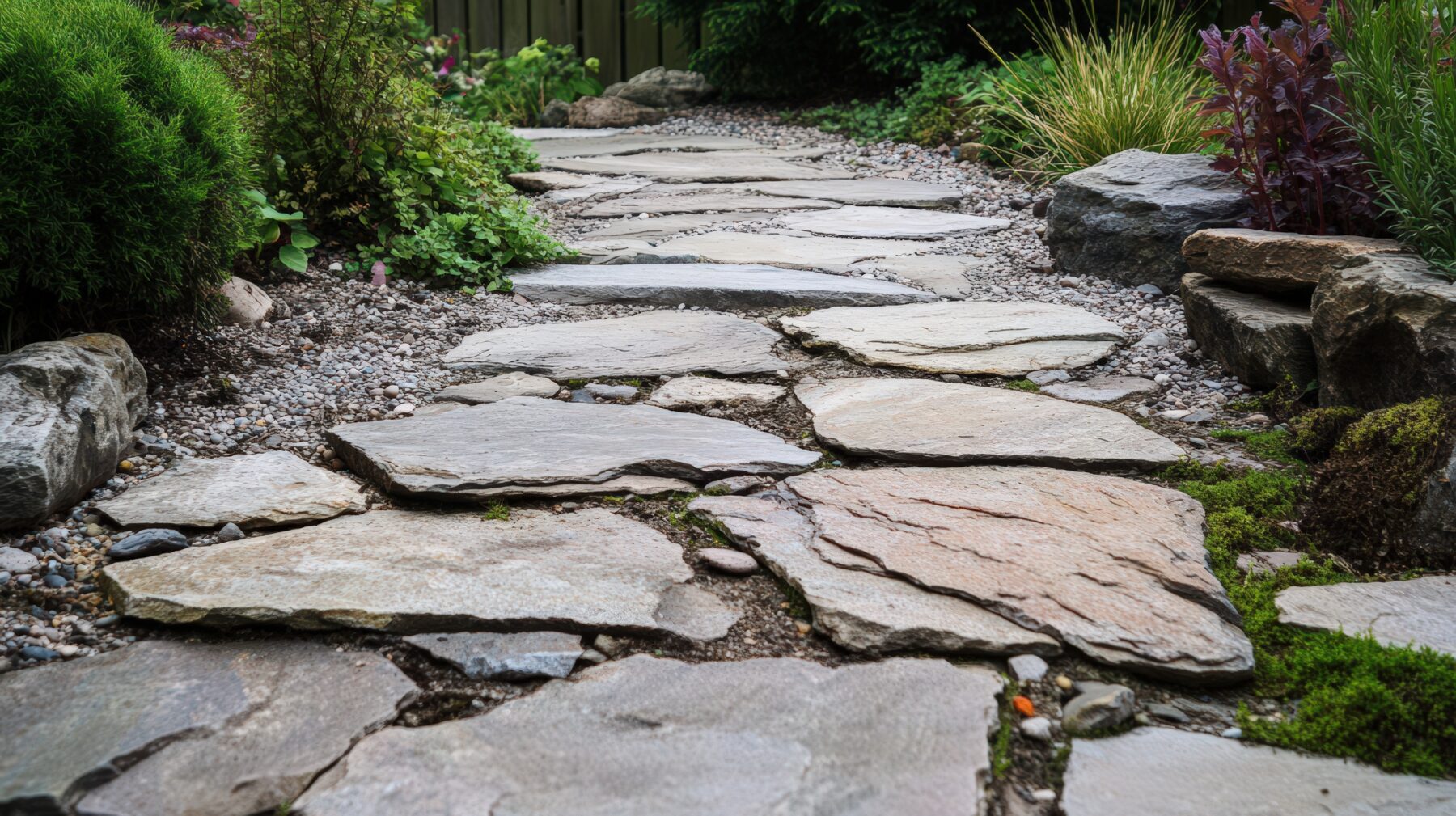DIY Flagstone Pathways: Combining Gravel and Stone for a Natural Look
May 5, 2025
Natural stone walkways continue to hold their place in landscape design for good reason. When thoughtfully constructed, they integrate into the surroundings with ease, enhancing the space without dominating it. Their strength lies in the simplicity of stone and gravel working in together to deliver a finish that feels both intentional and naturally embedded.
A flagstone pathway with gravel fill embraces an organic design, prioritizing character and texture over symmetry and precision. The result is a pathway that blends seamlessly into its surroundings, feeling like a natural extension of the environment rather than an imposed structure.
The Perfect Pair: Why Flagstone and Gravel Make Magic Together
Flagstone has the type of uneven edges and earthy tones that bring movement to a space. Each piece is slightly irregular, adding visual interest without needing excessive ornamentation. However, gravel softens the transition between stones and surrounding ground, acting as both filler and contrast.
While this paring adds visual appeal, gravel allows for higher quality drainage compared to concrete or mortar-set paths. It reduces runoff, helps control weeds with proper layering, and is far easier to adjust or repair if changes are needed down the line. There is no requirement for sophisticated landscaping knowledge or heavy machinery. A plan, patience, and an understanding of how the materials should interact are essential.
Building a Strong Foundation: The Key to a Lasting Path
The construction of a flagstone path begins with the preparation of stone. The longevity, stability, and drainage of the structure are all dependent on the base. The path will shift, settle unevenly, or invite weeds into every gap if this phase is overlooked.
The initial layer should consist of a compacted sub-base, which is typically composed of gravel or crushed stone, forming the structural bed. Above that sits the leveling layer, typically made from decomposed granite or stone dust. It cushions the flagstones and allows for minor adjustments during placement.
Before proceeding to the next layer, it is necessary to compact each layer. Shortcuts at this stage often lead to maintenance issues in the future.
Placing and Replacing Stones with Ease
Working with irregular stone is not only about perfection but also about balance. Each piece should be arranged in a manner that is both natural and cohesive, allowing sufficient space for gravel fill. A placement that is too close may appear artificial, while gaps that are too wide can be difficult to navigate.
The primary walking surface should consist of larger flagstones. Smaller flagstone pieces can be used to create smoother transitions along irregular edges or to close broader gaps. The layout process benefits from regular visual checks at different angles to maintain balance and consistency across the path. Taking the time to assess placement throughout ensures a more cohesive final result.
Utilize a rubber mallet to secure each stone in its designated location. Each stone should nest into the base material with a slight wiggle. Leveling does not necessarily imply a flat surface but rather a consistent footing aligned with the surrounding stones.
Gravel’s Role: Stability, Style, and Functionality
Gravel selection plays a critical role in the overall stability of a flagstone path. While pea gravel is usually considered, its rounded shape offers less interlock and can lead to movement over time. Angular options, such as crushed granite, provide stronger interlocking properties and create a more secure and durable surface.
Once the stones are in place, gravel is swept into the joints. This prevents the stone from moving while allowing water to pass through. Any settling that occurs can be fixed by applying a second application after a week of foot traffic. Over time, the gravel compacts further, holding everything in place without the need for mortar or adhesives.
In this circumstance, there is minimal maintenance required. The gravel is prevented from overflowing beyond the borders with a quick periodic sweep. Then, any displaced stones can be repositioned without the entire path needing to be pulled up.
Designing with Nature: Letting the Landscape Guide Your Path
Flagstone paths thrive when they follow the flow of the landscape rather than cutting across it. Subtle curves and shifts in the layout allow the pathway to align with the surrounding landscape. This flexibility supports natural movement around trees, gentle elevation changes, and transitions between outdoor zones, maintaining flow without interrupting the environment’s existing structure.
The path is defined and integrated into its environment by edging it with low plants or mulch. Cohesion is the objective, not contrast. This is where the value of combining gravel and stone becomes clear. It serves as a complement rather than being in competition with the surrounding environment.
A flagstone and gravel path that is well-constructed is not simply a way of traveling through a space. It becomes a part of the environment. A path that is both purposeful and grounded is influenced by the presence of each stone and gravel piece. Together they provide an excellent return on investment, both visually and functionally, for those seeking to enhance their landscape with a natural and enduring material.


